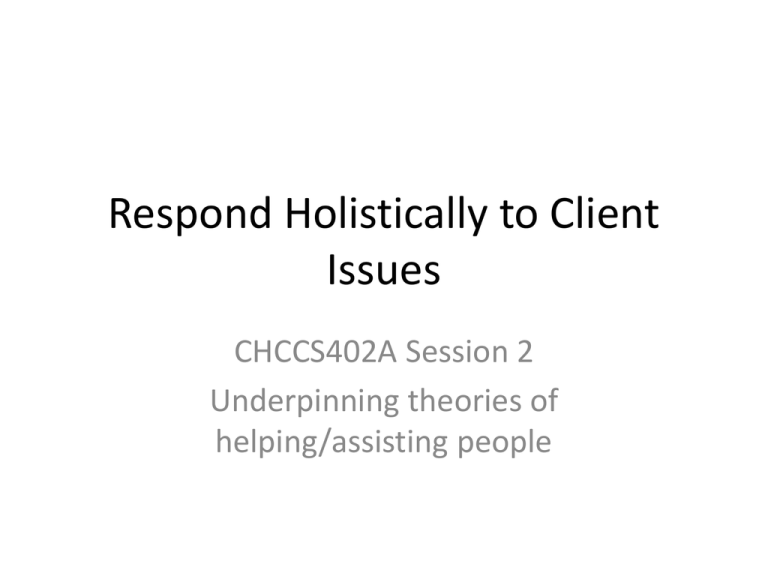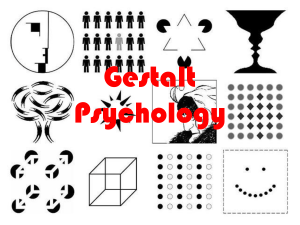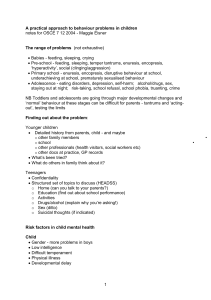Respond Holistically to Client Issues
advertisement

Respond Holistically to Client Issues CHCCS402A Session 2 Underpinning theories of helping/assisting people Why do we need theories? • Theories help to provide a framework or scaffolding on which we base our interventions. • They mean that what we do in assisting others is more than ‘common sense’ and is based on an understanding of human behaviour and personality Evidence from therapy outcome research, factors that influence successful outcome in therapy 15% Placebo Factors 40% 15% Technique/Model Factors Relationship Factors Client Factors 30% Data from Lambert, 1992 The major theoretical models • • • • • • • • Psychoanalytic theory Existentialist/Humanistic theories Person centred therapy Gestalt Cognitive behavioural interventions Narrative therapy Solution focussed therapy Strengths based approaches Psychoanalytic theory • Not frequently used today (too slow and expensive, some ideas outdated) • Remains very influential in current thinking and practice • Beginning of the ‘talking cure’ for psychiatric problems Sigmund Freud 1856 to 1939 • German Psychiatrist, known as the father of psychiatry Freud’s Ideas • Regarded his work as a psychiatrist as psychotherapy, that is, a process that assisted his patients to resolve previously unresolved issues. • Recognised that talking about issues through counselling and psychotherapy were a valid way of helping people. The unconscious mind • Disturbed human behaviour has its origins in the unconscious processes of the individual. • An individual’s beliefs, attitudes, thoughts and emotions have their origins in the unconscious. • Freud was interested in the interpretation of dreams as a way of understanding the unconscious mind. Free association • The patient talks freely about their life and one idea triggers another, then another. • Because the patient was able to talk freely; free association would occur and inevitably reveal ideas that were suppressed into the unconscious. • This is a helpful concept in allowing clients to freely discuss their thoughts and feelings without interruption. The importance of the past • Freud emphasised the past, especially childhood experiences. • One of his major contributions to the study of human behaviour is the concept that “the past influences the present.” Defence mechanisms • Those ways of behaving which protect the person from dealing with current painful issues eg repression, avoidance, resistance etc. • Understanding an individual’s defence mechanisms can be helpful in assisting clients to identify and deal with painful issues. The Id, Ego and Super-ego • The Id (the primitive, basic part of us), the only part present at birth. It is demanding and operates on the ‘pleasure principle” • The ego begins to develop in the first 12 months, when the baby learns that demands are not automatically met. This is the rational part that can delay gratification. • The ego uses memory and reason The super-ego • The super-ego is the conscious or moral self which is concerned with meeting the demands of society. • The super-ego demands perfection • Develops around 2 to 3 years of age at the stage of toilet training and when children learn about ‘good’ and ‘bad’ behaviour A joke about personality • The id says “I want it and I want it now” • The superego says, ‘you can’t have it, it’s bad for you.” • The ego says, “Well maybe you can have some of it-later’ Freud’s view of the healthy personality • All three aspects are kept in balance • If you are controlled by the id-impulsive and selfish • If you are controlled by the superego-rigid, moralistic and bossy • Those with a weak ego cannot balance personal needs and wishes with social duties and realistic expectations Freud’s view of psycho-sexual development • The oral stage (sucking, pleasure from nursing) • Anal stage (focussed on toileting) • Phallic stage (boys are focussed on their penis, girls on their lack of one) • Latent stage • Genital stage (adolescence & sexual maturity) A few final points • The ego is like the referee between the id and the superego. • A healthy personality is able to love, work and play. • Many of Freud’s terms and ideas are now part of our language and culture. Criticisms of psychoanalysis • It is a very long and slow process, often taking several years. The use of free association provides the client with little feedback. • The psychoanalyst is the “expert” who would help the client gain insight by interpreting the information the client has disclosed. • Many of the ideas are now seen as outdated So why study psychoanalysis Key concepts remain important in understanding human behaviour • The importance of clients being able to talk freely • The unconscious and how it influences behaviour (defence mechanisms) • The influence of past experience on present behaviour and emotions. Humanistic/existentialist theories • The basic premise of this model of counselling is that the individual has within themselves the capacity for personal growth. • Humanism is a non-religious philosophy which highly values human beings. Client centered therapy • • • • Carl Rogers 1902 to 1987 American psychologist The client is a person seeking help who is respected and valued Person centred therapy • Developed by Carl Rogers • It is particularly useful in the early stages of the client-counsellor relationship as it assists greatly in the establishment of rapport and building of trust • Works well with clients who have good verbal skills, but may take longer than some other methods of counselling. Gestalt therapy • German psychiatrist 1893 to 1970 • Trained in psychoanalysis but later developed Gestalt therapy. • Focussed on ‘here and now’ rather than the past. • Encourages clients to take responsibility rather than blame others for past issues Key elements of Gestalt • Perls concentrated on raising the client’s awareness of present bodily sensations, feelings and related thoughts. By becoming more aware of the present, his clients were able to sort through “unfinished business” from the past and sort through their emotional confusion, therefore having a “Gestalt” or “aha” experience. • Perls used a more challenging or confronting style of counselling in order to move people forward. • It can be useful to use Gestalt techniques at various times during the counselling process. However, they need to be used within the context of a Rogerian style counsellor-client relationship Gestalt techniques • Giving the client immediate feedback about nonverbal behaviour as it is observed in the counselling process (useful in drawing the client’s attention to feelings that are suppressed) • Inviting clients to get in touch with and describe bodily sensations and relate these to emotional feelings and thoughts • Encouraging clients to make “I” statements and to take responsibility for their actions • Challenging and confronting what the client sees as “neurotic” behaviour, for example confronting clients when they deflect away from talking about troubling issues Encouraging clients to role play parts of themselves and create a dialogue between those parts Double chair work Encouraging clients to role play themselves and someone else with whom they have a problem and create a dialogue between themselves and another person. Limitations/risks with gestalt • Gestalt techniques may be too threatening for some clients and need to be used only in those situations where clients feel comfortable and have the skills to manage any negative emotions which may arise. • Gestalt techniques need to be used by experienced therapists. Cognitive behavioural therapy • Albert Ellis • American psychotherapist • 1913 to 1997 • Studied psychoanalysis but later developed cognitive therapies Albert Ellis’ contribution • Pioneering approach to psychotherapy • In 1953 began developing REBT (Rational emotive behavioural therapy) as way of making emotional and behavioural change through challenging self defeating thoughts. • Second most influential psychologist of 20th century (American Psychological Association) What is CBT? • Cognitive Behavioural Therapy is a cost effective way of assisting clients change their behaviour. • It is less emotionally draining for the counsellor and client, as strong emotions are not expressed as often during counselling. • Research indicates that CBT works for many clients experiencing anxiety and depression The basic concept of CBT is that negative thoughts about a particular situation or event lead to negative feelings and behaviour. Activating Event leads to Beliefs and thoughts leads to Consequences (feelings and behaviour) • By helping a client understand that their thoughts and patterns of thinking can lead to negative feelings and behaviour, they can begin to challenge their negative thought patterns. • CBT assists clients to understand, manage and change thoughts and behaviours. • As an example the concept of helpful and unhelpful thoughts is very useful in assisting clients recognise their negative thought patterns. Some unhelpful thought patterns or “thinking errors” include exaggerating, black and white thinking, making assumptions, questions with no answers, catastrophising. Narrative therapy • Michael White, the guiding genius of narrative family therapy, began his professional life as a mechanical draftsman. But he soon realized that he preferred people to machines and went into social work where he gravitated to family therapy. The concept of narrative therapy • In developing the notion that people's lives are organized by their life narratives, White came to believe that stories don't mirror life, they shape it. • That's why people have the interesting habit of becoming the stories they tell about their experience. • Narrative therapists break the grip of unhelpful stories by externalizing problems • By challenging fixed and pessimistic versions of events, therapists make room for flexibility and change, allowing new and more optimistic stories to be developed. Key Concepts • The client tells the story of how a problem has affected their life (the dominant story) and re-telling the story as a new and preferred story (alternative story). • Narrative therapists recognise that the problem is the problem not the person. They acknowledge that people retain only part of the huge amount of information and experience and that the things we notice and remember tend to reinforce our “story” or world view. As an example • People can become stuck in a story that affects their happiness and perhaps the happiness of others. • A negative story may be “I am worthless and unlovable, I am no use to anyone”. New experiences are interpreted through this story. • Narrative therapy assists clients to identify exceptions to this dominant, negative story. This is similar to a previous concept of life scripts which people were given and were difficult to change. Solution focussed therapy • Steve de Shazer 1940 to 2005 • Started career as a musician • Developed brief solution focussed therapy in 1988 Key principles • Externalizes problems from people • Looks at solutions rather than focussing on the problem • Acknowledges strengths and resources • Solution-focussed therapy focuses on what the client is doing that is already working • Looks for times when the client has been successful in the past and when they used coping skills successfully. • Looks for an exception that is when the client has used successful and adaptive behaviours. Class exercise • Watch the video segment and discuss how the worker externalised the problem and the effect that this had. Strengths Based Approaches • This popular approach simply focuses on strengths rather than deficits. It draws on earlier models especially humanistic approaches, solution focused therapy and narrative therapy. How do we define strengths • A “person’s physical, intellectual and interpersonal skills, capacities, interests and motivation” (Mallucio, 1981 in McCashen, 2005: p.7, St Lukes Publications, Victoria). • Other resources such as neighbours, friends, family, material resources can also be seen as strengths. Often overlooked strengths include dreams, hopes and aspirations. Values underpinning the strengths approach • All people have strengths and capabilities • People can change • People can change and grow through their strengths and capacities • People are experts on their own situation • The problem is the problem; the person is not the problem • Problems can blind people from noticing and appreciating their strengths and their capacity to find their own solutions • People have good intentions • People are doing the best they can • The power for change is within us So which model will I use? • Many counsellors draw from a number of theories or models to develop their own framework for practice. • This serves as a “psychological rudder” which guides the counsellor in their practice. • Our approach will depend on our own style as a counsellor and the personality and needs of our clients. The integrative or eclectic approach • An eclectic approach may incorporate the Rogerian approach to build a relationship with the client and establish trust, psychoanalysis gives us an understanding of the unconscious and how it influences behaviour, while Gestalt, CBT, REBT, narrative and solution focussed therapy provide us with a range of techniques and strategies to assist clients move forward. Individual reflection • Which style of counselling/intervention do you think you would like to use in the future? • Why have you chosen this approach? • Discuss your ideas in groups of 3 to 4. Values exercise • From the cards you have been given which 5 cards best reflect your values as a community services worker. • Trade or swap your cards to get the hand that best reflects your values. • Share your cards with the group, explaining why you have chosen those values.



